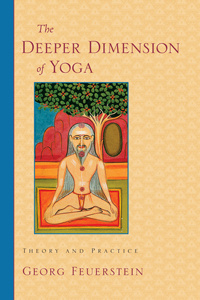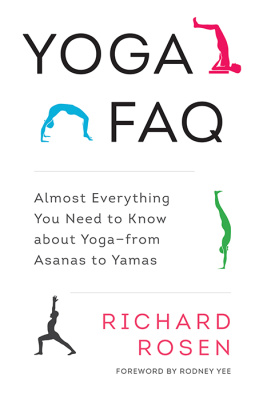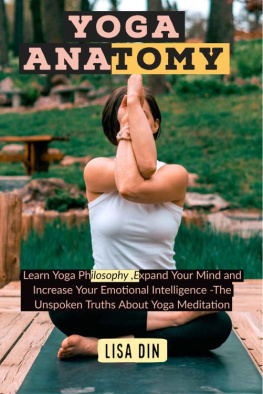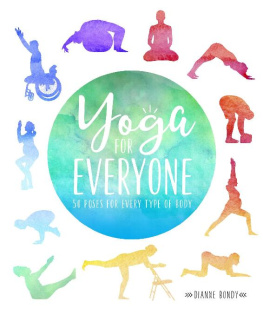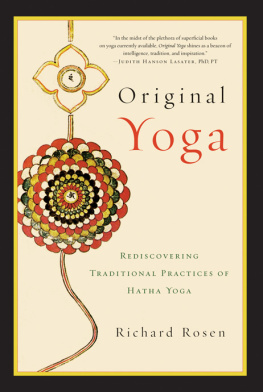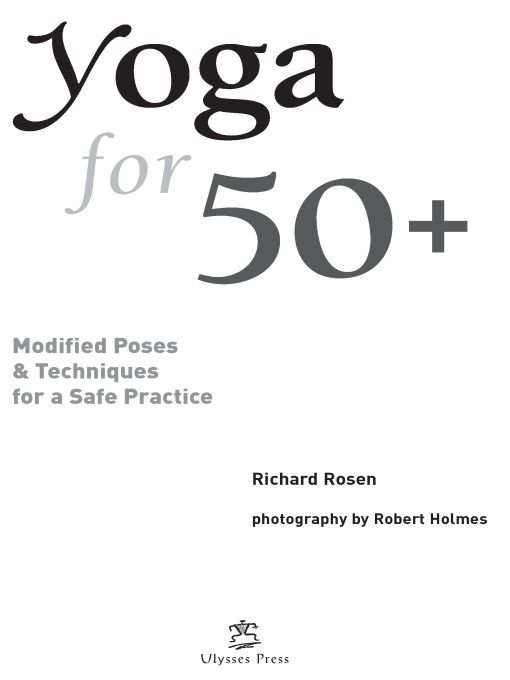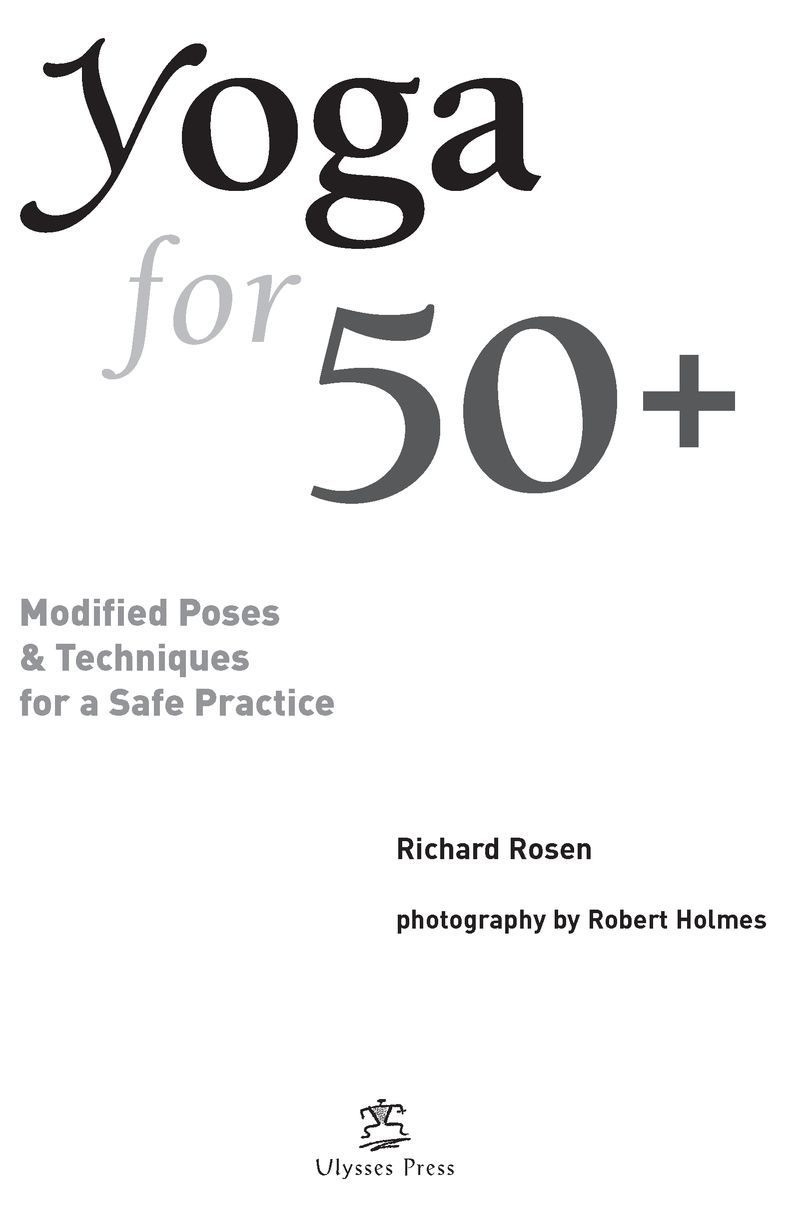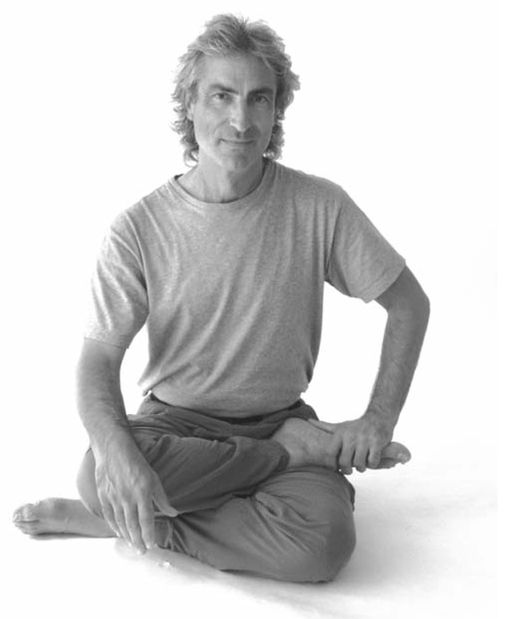Table of Contents
part one:
yoga basics
introduction
I turned fifty a few years ago. I didnt think much about itthat is, until the envelope arrived from the American Association of Retired Persons (AARP). Once you hit the half-century mark, Uncle AARP wants you. Uncle AARPs sudden interest in my age snapped me out of my complacencyor was it denial? Anyway, my first response was, Me, retire? Not in this lifetime.
Then I got to thinking about my yoga practice, and how my age had affected it. After some rumination, I realized that a couple of things about my practice or, more exactly, my body, had changed. I was a little stiffer, especially in the backs of my legs. I was also a little weaker: my handstands were quivering after only a minute when before I could hold on for two minutes or more. But my balance seemed okay, as did my endurance: I still started every practice session with fifteen to twenty rounds of Sun Salute.
The good news was that, after nearly a quarter-century of mostly regular practice, I was in touch with my body, including its intangible aspects. I might have been a tad looser and stronger when I was forty, but at fifty, I was a heck of a lot more intelligent about my body. My age had adversely affected my body to some degree, but my practice had very definitely softened the blow of advancing age. And I thought to myself, Thanks, Yoga.
You may believe that as you age, its inevitable that your body wont work as well as it did ten or twenty years before, and theres some truth in this. But wait, all is not lost. Most experts agree that you can do something to counter the usual effects of aging, and that something is exercise. Just about any exercise, or combination of exercises, will work wonders. The only requirement is that you exercise regularly, at least four times a week, for about twenty minutes each time.
Unfortunately, just when you most need to get up and be active, you might shut down. Im too old, you might think. Or (pick one), Im too heavy. Its too hard. Im too fragile. Im too weak. Im too stiff. Its too boring. Its expensive. Im too busy. Im too tired.
Typically, as we age, we become increasingly aware of, and try our best to avoid risky behavior. But studies suggest that one of the riskiest behaviors is not exercising. And it seems to me that yoga practice is particularly well suited to the task of keeping a person in peak condition.
Now, you might wonder whether a person in midlife needs a special book to teach him or her yoga. There isnt any reason that a fifty-yearolds practice has to be all that much different from a twenty-year-olds practice... eventually. At the start, though, you have to pace yourself more slowly than the average twenty-year-old, especially if youve been living a sedentary lifestyle, so that you dont overtax bones and joints, especially the knees, lower back, and neck.
The material in this book is basic, written with the beginner in mind. The book is divided into four parts, with an appendix tagging along at the end. Part I, this part, is like the foundation of a building: it contains information that youll need to know before you get started, so please dont skip right to Part II. Part II is like the foyer: its dozen simple exercises are an entranceway to the poses in Part III. Part III is the main room, consisting of about fifty poses, or asanas, many of them modified for beginners. Part IV puts the roof on the project, finishing with a couple of basic but essential breathing exercises. The appendix is like the houses decoration: it talks about how to sequence your practice, gives you some sequencing ideas, discusses how to keep yourself and your practice inspired over the long haul, and tells you how to find yourself the perfect yoga teacher.
Richard Rosen
what is yoga?
The language of traditional yoga is Sanskrit. Its not spoken much nowadays, but once upon a time it was the tongue of Indias educated elite. Sanskrit is an enormously evocative language, although not particularly easy to learn. But you should become acquainted with the Sanskrit names of the poses in this book; their meanings often provide hints about the subtler aspects of the poses.
Yoga is very old, two thousand years, at least. Tradition holds that the father of yoga is Hiranyagarbha (pronounced here-ahn-yah-garbah), Sanskrit for golden seed. Western scholars tell us that Hiranyagarbha is likely a legendary character, and that yoga is probably the product of a group effort spanning several generations of practitioners.
The word yoga comes from the word yuj, to yoke. This verb is the distant ancestor of a number of familiar English words, including join, junction, and conjugal. Although most Westerners equate yoga solely with the poses, or asanas, this is a misconception. Theres actually no one practice you can point to and say, Thats yoga. Historically, there have been more than thirty distinct schools of yogamost of them only marginally interested in asana, if at all. Some of them are still alive; others are extinct.
But whatever the school (even Hatha Yoga, the Wests most popular form of yoga), yoga is essentially the practice of concentration training, or meditation: the persistent, methodical contemplation on the nature of the authentic self. This self isnt restricted to the mind, with its unceasing parade of thoughts, feelings, memories, fantasies, and so on. Yoga has a holistic view of the self that includes the body; the everyday lower mind; a higher mind, or insight-wisdom faculty (called buddhi, from budh, to be awake); and the atman, soul.
The central question that all yoga meditation tries to answer is, Who am I?; or, if you flip the coin over, How can I be truly happy? The ultimate goal in most yoga schools is to realize the selfs identity with, and then yoke it to, its Source, which the yogis call Brahman, the vast expanse. This may sound, at first, out of reach for the average person. But anyone who makes an honest effort will sample something of this lofty end.
Although the founders of traditional schools are often unknown or legendary characters (such as Hiranyagarbha), the founders of popular modern schools are widely known. Four of our most famous teachers are the students of one extraordinary man, a Brahmin Indian by the name of Tirumalai Krishnamacharya (1888- 1989), whose work and teaching changed the face of yoga in the twentieth century. These teachers are Indra Devi (ne Eugenie Peterson, 1899-2002), Sri Krishnamacharyas first female student, who opened the first yoga studio in the United States in Hollywood in 1947; B. K. S. Iyengar (b. 1918), Sri Krishnamacharyas brother-in-law and author of the modern classic Light on Yoga; K. Pattabhi Jois (b. 1918), the leading light of Ashtanga Vinyasa Yoga; and T. K. V. Desikachar (b. 1938), Sri Krishnamacharyas son, and the originator of Viniyoga.
general benefits of yoga
Yoga is, first and foremost, a spiritual practice. But the practice has a number of physical benefits. One text from the fourteenth century asserts that through yoga the body becomes lean and glows (




